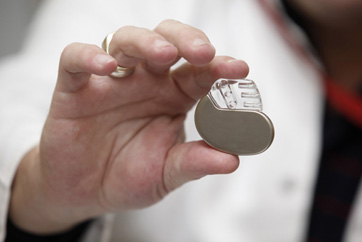No evidence electric cars interfere with cardiac devices

Electromagnetic interference from electric cars does not affect the function or programming of cardiac implantable electronic devices, or CIEDs, according to results published today in Annals of Internal Medicine.
“This study suggests that there need not be restrictions imposed on the use of electric cars by CIED patients with the caveat that caution should still be exercised,” Carsten Lennerz, MD, MSc, of the German Heart Center at the Technical University of Munich, told Healio Internal Medicine.
Between May 2014 and January 2015, Lennerz and colleagues enlisted 108 patients with CIEDs being seen for routine follow up to assess the risk for electromagnetic interference (EMI) from electric cars to CIED function and programming. The CIEDs of the 108 patients were from seven manufacturers and had 42 device families and 42 lead families with many indications, including pacemaker therapy (n = 34) and implantable cardioverter defibrillator therapy (n = 74). Patients were excluded if CIED battery life was less than 3 months or there was a suspected lead malfunction. Depending on vehicle that was available at the testing facility during the time of visit, patients were assigned to one of four electric cars with the largest European market shares, including the BMWi3, Nissan Leaf, Tesla Model 85S or Volkswagen e-up!. Hybrid vehicles were excluded from the study.

Lennerz and colleagues measured the magnetic field strength in and around the cars while they rolled on a roller test bench and the participants sat in the front seat. Further, magnetic field strength of the charging cables was measured while the participants charged the same car in which they initially sat. Finally, investigators drove the cars on public roads while the magnetic field strength inside the vehicle was measured as well. According to the study, two cardiologists, who were blinded to the participants and cars, independently analyzed patient electrocardiograms to assess CIED function. Researchers examined device event monitors and device settings to detect tachyarrhythmia as well as false or phantom programming.
Field strength was highest during charging (30.1 to 116.5 T), increased as the charging current increased and did not differ between the front and back seats, Lennerz and colleagues discovered. Similar field strength measurements were observed inside the cars during the open road tests as well as the roller bench tests, according to the study.
Researchers concluded that there is “no evidence of EMI with CIEDs” and no adverse effects, such as inappropriate pacing or pacing inhibition, periods of oversensing or undersensing or device reprogramming (incidence of EMI, 0% [95% CI, 0-3.4]), were detected in any of the study participants. Additionally, no adverse effects were observed during postexposure testing. Although EMI was discovered by the electrocardiographic recorder, CIED function and programming remained unaffected.
Lennerz and colleagues recognized that although rare events were not detected because of the small sample size, electric cars still appear safe for individuals with CIEDs. Function and programming of CIEDs were not affected by electric or magnetic fields generated during the operation or charging of the cars, and researchers noted that restrictions for patients with CIEDs may not be required. However, further research and monitoring is recommended.
“Ongoing vigilance and registries of patients with CIEDs using electric cars should be maintained to evaluate for rare events,” Lennerz said. “Given the rapid change of technology, these results should be frequently re-evaluated, especially in the context of future ‘super-charging’ units that have greater potential for EMI.”
Disclosures: Lennerz reports no relevant financial disclosures. Please see the full study for all other authors’ relevant financial disclosures.
